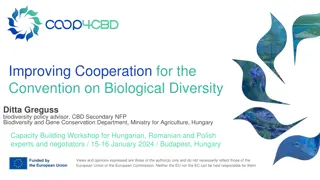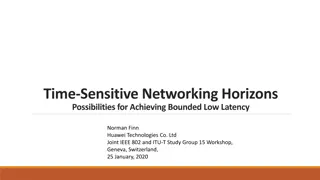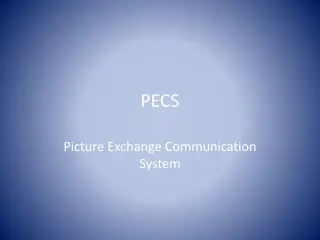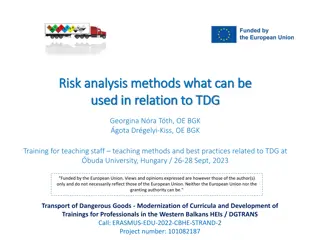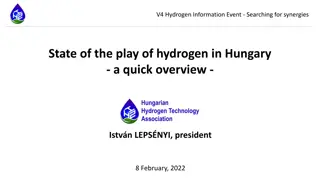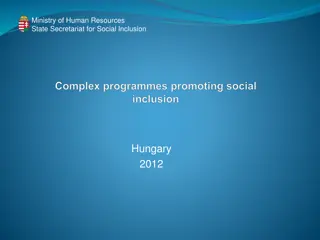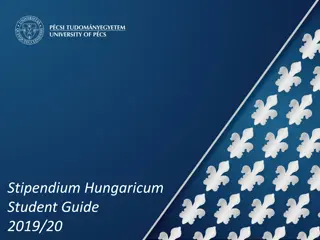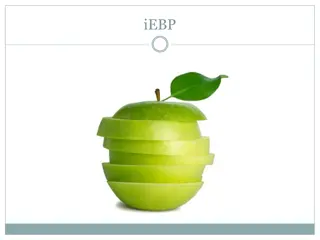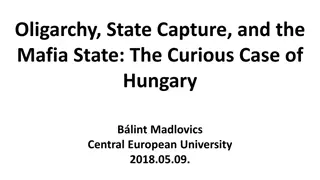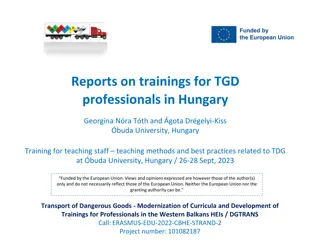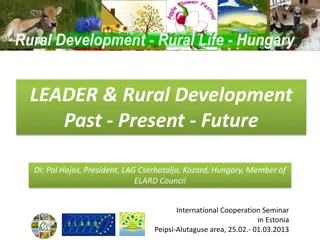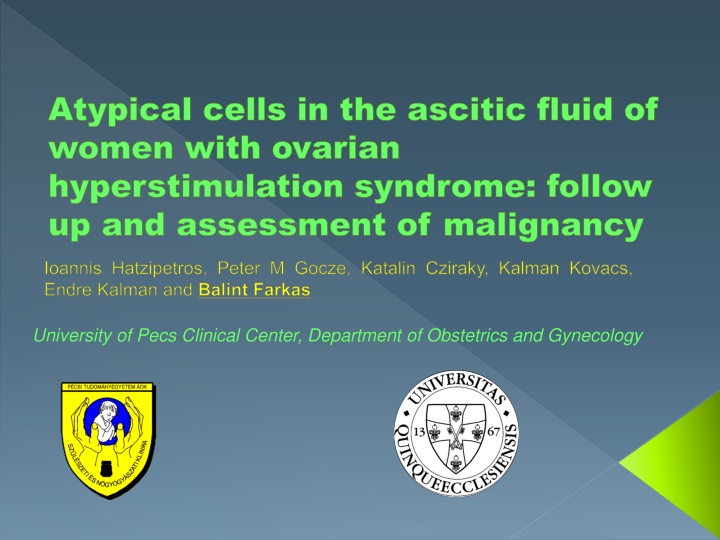
Ovarian Hyperstimulation Syndrome and Infertility Trends: Insights from Research
Explore the relationship between atypical cells in ascitic fluid of women with ovarian hyperstimulation syndrome, infertility rates, and the safety of in vitro fertilization procedures. Discover the implications of ovarian cancer risk and population dynamics on reproductive health.
Download Presentation

Please find below an Image/Link to download the presentation.
The content on the website is provided AS IS for your information and personal use only. It may not be sold, licensed, or shared on other websites without obtaining consent from the author. If you encounter any issues during the download, it is possible that the publisher has removed the file from their server.
You are allowed to download the files provided on this website for personal or commercial use, subject to the condition that they are used lawfully. All files are the property of their respective owners.
The content on the website is provided AS IS for your information and personal use only. It may not be sold, licensed, or shared on other websites without obtaining consent from the author.
E N D
Presentation Transcript
Atypical cells in the Atypical cells in the ascitic women with ovarian women with ovarian h hyperstimulation yperstimulation syndrome: follow up and assessment of malignancy up and assessment of malignancy ascitic fluid of fluid of syndrome: follow Ioannis Hatzipetros, Peter M Gocze, Katalin Cziraky, Kalman Kovacs, Endre Kalman and Balint Farkas University of Pecs Clinical Center, Department of Obstetrics and Gynecology
The current study was funded by: 1, SROP-4.2.2.A-11/1/KONV-2012-0053 Investigation of biomarkers in culture medium for the success rate of in vitro fertilization. University of P cs, J nos Szent gothai Research Centre P cs, H-7624, Ifj s g str. 20., Hungary 2, MTA-PTE Human Reproduction Scientific Research Group. Hungarian Academy of Sciences (MTA) and the University of Pecs (PTE), P cs, Hungary.
Population explosion; human race is leaving an ecological footprint on the planet in 2012.
Less Developed Countries are responsible for this linear increase in the population in, while the population in the Developed Countries is constant or slightly decreasing. Source: www. prb.org
Hungarian population fall in the 20th century Source: Hungarian Statistical Office, Demographic Yearbook, 2011.
Growing rate of infertility growing need of ART Based on data from the National Survey of Family Growth (NSFG), women aged 15 44 who had ever used infertility services increased from 9% in 1982 to 15% in 1995, then declined to 12% in 2002, and remained at that level in 2006 2010. Etiology: - Male 25 % 27 % 22 % 9 % 17 % - Ovulatory - Tubal / uterine - Other - Unexplained
Is in vitro fertilization safe? Egg-retrieval procedure complications Miscarriage: about 15 - 20 % Twin gestation: increased risk, if more than one embryo is implanted into the uterus. Premature delivery and low birth weight: IVF slightly increases the risk. Birth defect: a, 8.3% vs. 5.8%, but IVF was not associated with greater odds, unlike ICSI, which was associated with a 57% increased risk. (Davies et al., NEJM, 2012) b, 9 % vs 6.6 % increased risk for major birth defects for infants born after IVF compared to naturally conceived infants (Kelly-Quon et al., AAP, 2012) Ovarian Hyperstimulation Syndrome (OHSS) Ovarian cancer: ?
Ovarian Hyperstimulation Syndrome (OHSS) Definition: Iatrogenic complication of ovarian induction therapy (OIT) resulting increased vascular permeability and subsequent fluid accumulation. Symptoms: - abdominal pain and distension - respiratory compromise (hydrothorax) - ascites and GI problems - oliguria - thromboembolism
Ovarian Hyperstimulation Syndrome (OHSS) Diagnosis: 1, antral follicule count 14 on a TVUS (82 % sensitivity, 89 % specificity Kvee et al. 2007) 2, basal anti-M llerian hormone level of 3.5 ng/ml (90.5 % sensitivity, 81.3 % specificity Nardo et al. 2009) Clinical forms: a, Mild (Grade 1 - Whelan et al., 2010) b, Moderate (Grade 2-3 - Whelan et al., 2010) c, Severe (Grade 4-5 - Whelan et al., 2010)
Ovarian Hyperstimulation Syndrome (OHSS) and ovarian tumors OHSS and struma ovarii (Balasch et al.,1993) OHSS and folliculoma (Willemsen et al.,1993) OHSS and serous papillary carcinoma (Komatsu et al.,1995) OHSS and mucinous cystadenoma (Grimbizis et al.,1995) OHSS and serous papillary cystadenoma (Grimbizis et al., 1995) OHSS and granulosa-cell tumor (Willemsen at al.,1993) OHSS and epithelial ovarian carcinoma (Goldberg et al.,1992) Shushan et al. In 1993 concluded that OIT with human menopausal gonadotropin might increase the risk of epithelial ovarian malignancies, specifically borderline ovarian tumours.
Aim of the study To determine whether women undergoing OIT at our IVF clinic, especially those with severe OHSS and suspicious cytologic findings, were at risk for developing malignant ovarian tumours after treatment, or not.
Methods Prospective study design. Clinical Centre of the University of Pecs Department of Obstetrics and Gynaecology/Reproductive Centre between January 2006 and December 2012. Severe OHSS patients were investigated, which cases US guided culdocentesis obtained ascitic fluid. Out of the collected cells smear was made, GIEMSA stained and evaluated by Papanicolau method under light microscopy. Peripheral blood was drawn for tumor marker level assessment (CA-125 and HE4).
Results 1587 women underwent OIT in 4892 cycles 23 patients (1.4 %) got hospitalized with severe OHSS None developed malignant ovarian tumour during the study period 9 / 23 underwent culdocentesis for severe OHSS
Case No. Age (y) Douglas puncture Ascites cytology Control histology OIT Remarks 1 28 05/2006 CC + hMG + hCG P IV 06/2006, neg.# Tumor-free 2 23 03/2007 FSH + hMG + hCG P IV 05/2007, neg.# Tumor-free 3 24 10/2007 CC + FSH P IV 12/2007, neg.# Tumor-free 4 23 10/2007 CC + hCG P IV 12/2007, neg.# Tumor-free 5 26 11/2007 CC + FSH + hCG P III 02/2008, neg.# Tumor-free 6 30 02/2008 hMG + hCG P III 04/2008, neg.# Tumor-free 7 26 11/2008 FSH + hCG P III 01/2009, neg.# Tumor-free 8 30 11/2009 GnRH-a + hMG + hCG P III 01/2010, neg.# Tumor-free 9 34 10/2012 GnRH-a + FSH + hCG P III-IV 12/2012, neg.# Tumor-free$ Dates are shown for Douglas puncture and control histology tests. OIT, Ovarian induction therapy; CC, Clomiphen citrate; hMG, Human menopausal gonadotropin; hCG, Human chorial gonadotropin; GnRH-a, Gonadotropin-releasing hormone analog; FSH, Follicle-stimulating hormone.
Laparoscopic examination was performed at 8 to 12 weeks after the culdocentesis. Inspection of the abdominal cavity, eluents from the Douglas pouch were sampled and histological samples were obtained from the ovaries.
Case No. Age (y) CA-125 (U/mL) HE4 (pM) ROMA (%) 1 28 45.2 40.1 4.9 2 23 27.1 47.9 7.0 3 24 505.8 38.2 5.0 4 23 40.5 39.9 4.8 5 26 19.2 51.6 8.1 6 30 9.8 45.6 5.2 7 26 38.1 45.2 6.2 8 30 56.3 37.4 4.2 9 34 210.3 40.1 5.3 The mean ( SD) value of CA- 125 was increased (105.81 161.55 U/mL) compared to the reference range of 0 to 39 U/mL. However, the mean serum level of HE4 (42.89 4.88 pM) was within the normal range of 0 to 150 pM.
Conclusions Even if OHSS indicates abnormality and possible malignancy, radical surgical intervention is not clinically indicated, instead these patients should be closely followed and monitored. - If the ovarian size remains abnormal, then the aetiology of the enlargement should be determined by histological sampling via laparoscopy, and the histologist should be informed of the previous OIT. - Large population-based studies will be required to determine if ovarian induction is associated with tumourigenesis over the long-term. -


